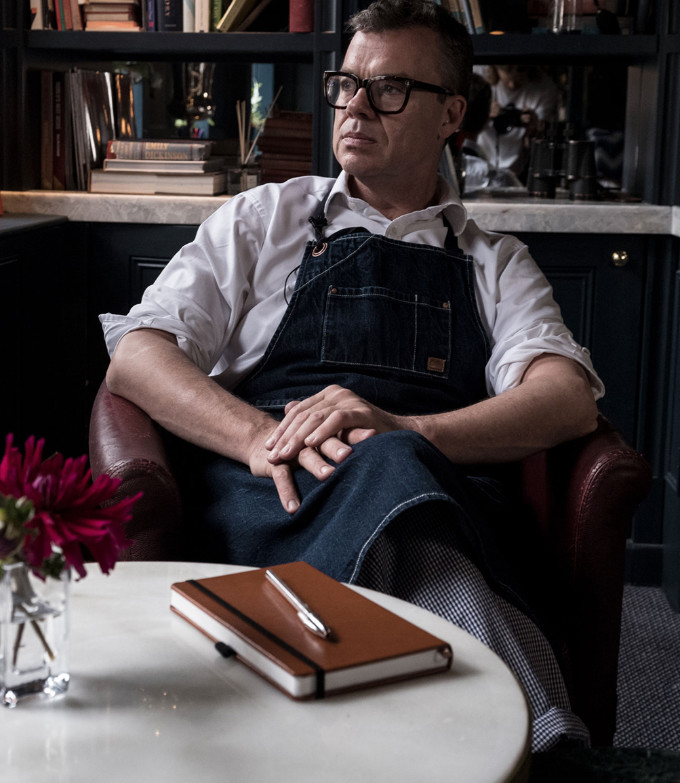What is a dish you grew up with?
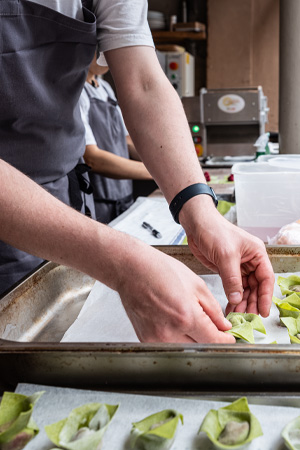
I grew up in North Wales with my family. We always ate home cooked meals growing up, and my mum, who is a good cook, liked to experiment, sometimes not with the greatest success. She still does actually; I was visiting her recently and she made a lasagne that was packed full of star anise, which I imagine she’d read about somewhere.
But my first distinct food memories are from Ireland. My mum’s from Tipperary, which is a short boat trip from where I grew up. So we went to see her family a lot, as much as six times a year.
It was a very humble life there. My granny lived in a bungalow which was on a huge farm. It was a very old property with thick stone walls. She lived there her whole life. They reared chickens, pigs and lambs. My mum would tell me that growing up, her grandma would cut the heads off chickens to prepare their meals, and get the blood from the pigs to make black pudding. She was a bit too old for that when I started visiting, but there would still be the same food on the table. Black pudding, white pudding, roasted joints of lamb. Simple, traditional cooking.
The one thing that would always be there, and it was one of my earliest food memories, was freshly baked soda bread. My grandma made soda bread every morning, until…she couldn’t. She would never weigh the ingredients. The dough was dark from the brown flour she would use and the buttermilk would be from a local dairy, or milk that was starting to sour. Before going in the oven she’d cut a big cross in the top, so the bread was always pulled off in quarters. I’d eat it every breakfast, warm from the oven, always with butter and sometimes with jam. I loved it!
She passed away earlier on in my cooking career so I was never able to ask her questions about her cooking. My mum still makes soda bread, but despite baking a lot of bread in my career, it’s never been something I’ve wanted to make, or put on a restaurant menu. I think maybe that’s because I want it to be reserved as a memory of my mum and grandma, of that time in my life.

What is the first recipe you remember following?
I remember being 12 years old and my sister would put the Naked Chef with Jamie Oliver on TV because she fancied him. Until that point, cooking had seemed quite boring to me, but he made it seem cool and fun. So on my 13th birthday I got the Naked Chef cookbook.
I found the book really exciting. I would get home from school and take out my mum’s food processor to make pasta dough. I’d roll the dough out with a rolling pin and end up with a pasta that was too thick, raw in the middle and tasted like crap. But that didn’t matter to me so much. I was just excited to read the different recipes and try these new things.
The first recipe from the book I remember nailing was a hazelnut semifreddo. You’d make a praline with hazelnuts and caramel, smashing it up, then mixing through sugar, egg yolks and whipped egg whites. Once I had gotten it right I started experimenting with different ingredients, using chocolate and honeycomb instead of the praline.
It was the first cookbook I had, and also the first cookbook that made me realise I wanted to be a chef.
What is the recipe you’ve made the most?
I would say it’s the fazzoletti with duck ragu. We’ve been serving that dish since our first pop up in 2019. It’s had a couple of tweaks since, but a version of it has nearly always been on the menu. Even though it’s essentially just a ragu with pasta and breadcrumbs fried in duck fat on top, it’s a dish that people just love and one I still don’t get bored of cooking.

We buy in whole ducks and butcher them down. The legs go into a pan with butter whilst the crowns go into another dish. We fry the legs in batches so they get a good colour and take on that buttery duck fat. Once cooked we take them out and add the offal to the pan, including the heart and gizzards. That offal then gets minced.
In the same pan we cook a soffritto of onion, carrot, celery, garlic and sage, then add the minced offal back in. That’s cooked down gently for about an hour, before adding tomato paste, a medium bodied red wine, chicken stock and the duck legs. There’s then a two hour braise before finally shredding the duck legs in the ragu.
In terms of the pasta, we use a dough made of 00 flour, semolina, whole eggs and egg yolks. The yolk to whole egg ratio is generally 2:1. It’s quite a firm dough, around 40% hydration. Your more classic ravioli dough tends to be closer to 50%, but with a pasta like this you want a little more bite. The reason we include the egg whites is to provide additional protein. Protein makes the dough easier to work with, allowing you to roll it more, creating air between the layers and getting lamination. By doing this you build up tension, structure and gluten, which will ultimately give you that great texture in your cooked pasta.
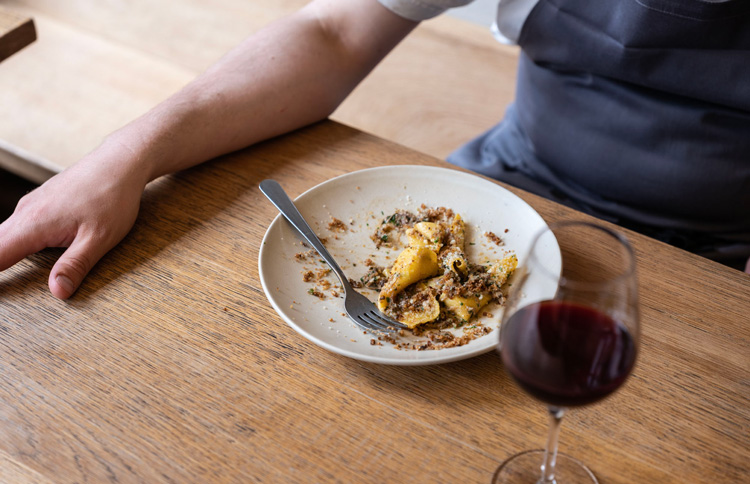
Once we make our dough, we leave it to rest for 24 hours. The dough is put through our rollers until we get very thin sheets. Fazzoletti means handkerchief in Italian so they should be thin squares measuring around three by three inches.
I first came across fazzoletti when I was reading Heat by Bill Bufford, and when I made it I found it a welcomed change from the slightly more ubiquitous pappardelle. I think the large squares of pasta work really well with the rich, shredded duck ragu.
When the cheque comes on, the ragu goes into the pan with a little butter and pasta water. Once the pasta is cooked, it goes in with the ragu and is tossed so it thickens up nicely, and then it’s finished with some parsley and a little sherry vinegar. Finally it’s topped with 22 month aged parmesan and breadcrumbs.
Those breadcrumbs are made from unused focaccia from the previous day’s service, which has been cut up, dehydrated, blitzed up into breadcrumbs and then cooked in rendered duck fat.
Who are the cooks or chefs whose recipes have inspired you?
As a young chef, Nose to Tail Cooking and A Kind of British Cooking by Fergus Henderson were a massive inspiration for me. They were the books I got at the start of my time in kitchens that really excited me, less about the recipes themselves, but more Fergus and St John’s ethos, and when I first moved to London the first restaurant I ate at was St John Bread and Wine. I ate there really regularly – there and Bocca Di Lupo. Having the opportunity to eat the bone marrow and parsley salad was something I felt so excited by. It’s an iconic dish, and like the best dishes in my opinion, it is deceptively simple with just a few ingredients. But it is the balance of everything that stuck with me – sharp dressing, salty capers, the bitter freshness of the parsley, raw shallots and then fresh toast and beautifully soft, fatty, roasted bone marrow. It is perfection.
 I was actually at a restaurant in North Carolina about seven years ago with some friends and we were chatting with the chef in the kitchen. They sent us a dish which, amazingly, they said they had worked on; roasted bone marrow, parsley salad and toast!
I was actually at a restaurant in North Carolina about seven years ago with some friends and we were chatting with the chef in the kitchen. They sent us a dish which, amazingly, they said they had worked on; roasted bone marrow, parsley salad and toast!
Then there are the books I still dip into now, occasionally taking ideas and recipes to help form new dishes. Prune by Gabrielle Hamilton is one of those books. I love her approach and there are so many recipes I’ve pulled from. Not so much here at Manteca, but at previous restaurants. You could describe her recipes as autobiographical cooking, with each dish linked to an experience in her life. The actual style of food is difficult to pin down, but there is a thriftiness to her cooking that really appealed to me. She has this pork tonnato recipe, for example, where she cooks a pork shoulder in octopus braising liquor. You know, really utilising all her ingredients to make innovative dishes.
“Locatelli’s recipes inspired me to use Italian cooking as a platform, but to also be unbound from tradition. I guess as someone who’s not Italian I’m more able to do that.”
Another book that’s important to me is Made In Italy by Giorgio Locatelli. It’s a book I bought right at the start of my career but keep going back to. I still use the amaretti biscuit recipe from that book, and you’ll occasionally find it on the menu here. They’re made with bitter almonds, which when I first got the book were not easy to find. But I remember baking them for the first time and thinking f*ck me, these taste amazing.
Locatelli’s books are packed with great little stories and give you a window into cooking throughout Italy. There are some traditional recipes in there but he’s also innovative and imaginative with his cooking. I think he has a cold tomato soup that he serves as a dessert and a very unconventional tiramisu that’s wrapped in a frangipane. I remember finding his recipes so exciting as a young cook. They inspired me to use Italian cooking as a platform, but to also be unbound from tradition. I guess as someone who’s not Italian I’m more able to do that.
What is the recipe you would hand down to your family?
 There are quite a lot of recipes I’m proud of, but there are a few that I feel are genuinely original to me. My pig skin ragu recipe is one of those, because whilst it follows a fairly traditional method of making ragu, its ingredients are quite unique. There is no meat, or rather, flesh, in the dish; it’s made from just pig’s skin.
There are quite a lot of recipes I’m proud of, but there are a few that I feel are genuinely original to me. My pig skin ragu recipe is one of those, because whilst it follows a fairly traditional method of making ragu, its ingredients are quite unique. There is no meat, or rather, flesh, in the dish; it’s made from just pig’s skin.
I guess this dish is based on that thrifty philosophy of cooking that I like. Because we get our pigs into the restaurant whole, we are left with a lot of skin after butchering the pork down for its different cuts. So I wanted to develop a dish that would make use of this excess ingredient.
Usually our pigs are Cornish Lops, Saddlebacks or Tamworth; native breeds that we’ve worked closely with our suppliers and butchers to source. When they come in we remove the skin and boil it down until it’s very, very soft. Some of that skin we chill, scrape off any excess fat, and then dehydrate, taking the texture all the way to what feels like a credit card. Then the rest of the skin gets minced, so you’re left with a gelatinous, sticky texture.
Meanwhile we make a soffritto with onion, carrot, celery, garlic and fennel. Fennel is a versatile vegetable and one that I use throughout the menu at Manteca. From fennel seeds and fennel pollen in the salumi that kicks off the menu, to the soffrittos of some ragus, sliced thinly in salads, and sometimes just roasted in olive oil to go through a cake on the dessert menu.
I really like the aromatics of fennel, some people think they don’t like it because they seem to be expecting something very strong in aniseed, which is obviously part of the flavour profile but if used in a clever way it can bring versatility to a dish. It pairs well with citrus and chilli and works with fat. These are big players in my food.
That all gets cooked down in pork fat for an hour or so. Then we add tomato paste and tinned san marzano tomatoes, the minced fat and a spice blend that includes fennel seeds, cayenne pepper, star anise and black pepper. That all gets braised again until you’re left with a delicious, rich ragu.
This dish doesn’t come with pasta, instead it’s served in a bowl with grated parmesan. Alongside it we serve a piece of the dehydrated skin, which has been fried until it’s puffed up and very crispy, like a chicharron, then dusted with the same spice blend that went into the braise. That skin is then used as a vehicle to scoop up and eat the ragu.
The dish is sticky and rich, it uses up a part of the pig that otherwise might go to waste, and is absolutely delicious.
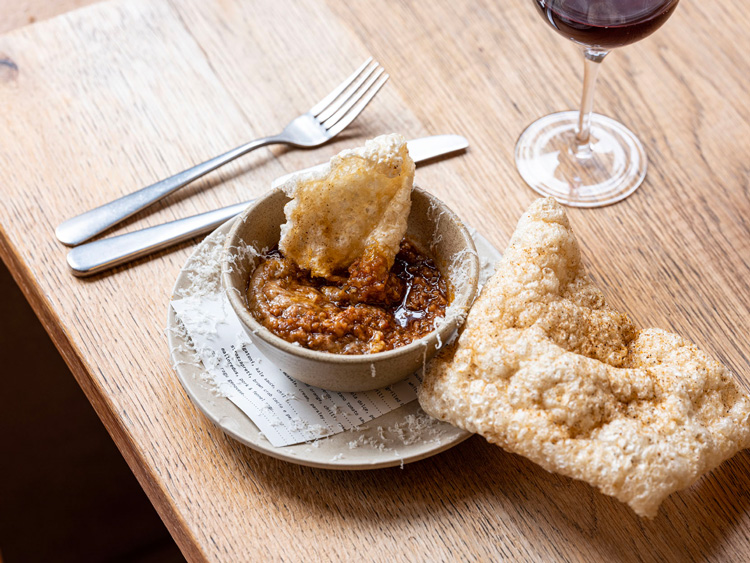
What is a dish on your current menu that represents your approach to cooking?
A dish I love serving at the restaurant is our rigatoni with kale sauce. It’s a dish that always seems to take people by surprise. It’s a beautiful vibrant green colour, and any time someone orders on the counter, they look excited when it’s put in front of them. The dish itself is simple, but it has a good balance of flavours; the right amount of acidity and a little bit of heat from the chilli. It’s just a very delicious, comforting pasta.
Despite the fact the dish is simple, that doesn’t necessarily mean easy. I think that is an important thing to remember when referring to things as simple. I think this approach to simplicity is how Manteca’s food is defined.
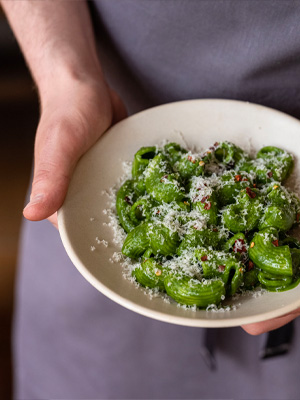 It’s a vegan recipe, but not created for that purpose. That’s something I always say to our team – I don’t want to put a vegan dish on the menu because it’s vegan, I want to put a dish on the menu because it’s delicious, the fact that it’s vegan is simply a bonus.
It’s a vegan recipe, but not created for that purpose. That’s something I always say to our team – I don’t want to put a vegan dish on the menu because it’s vegan, I want to put a dish on the menu because it’s delicious, the fact that it’s vegan is simply a bonus.
There are few ingredients but how they are prepared is important. To make the dish we blanch cavolo nero until it’s quite soft, and remove it from the water. In a pan we cook some garlic in olive oil, cooking it very gently so it’s confited. That’s then blitzed together before being added to a pan with the rigatoni and pasta water. Sometimes, and of course when it’s not vegan, we will add a little butter and cheese. We then finish the dish with a sprinkle of dried chilis for some heat, and a squeeze of lemon to round off the flavours.
The cavolo nero comes from one or two of our partner farms/growers we work with so is only available when in season. When buying cavolo nero make sure you buy very dark green leaves, they should feel quite firm and make sure they are not turning yellow. When you strip the leaves, don’t throw away the stalks! We finely chop them up and mix with 2% of their weight in salt. This is then lacto-fermented for 5-7 days which we then use to add a little acidity to salads or add to meat ragus.
“Despite the fact the dish is simple, that doesn’t necessarily mean easy. I think that is an important thing to remember when referring to things as simple. I think this approach to simplicity is how Manteca’s food is defined.”
The kale needs to be cooked enough to blend properly, but not too much that it will turn brown as a completed dish. It needs to be finished with just enough lemon to balance it, and a sprinkle of dried chilli gives a gentle heat. We are really lucky to be able to work with some amazing suppliers, one of these is Ren’s Pantry – Ren Patel sources the most amazing spices and dry store/pantry products so we always get our dried chillies from her.
I think a short pasta works best for this dish, but a long pasta like bucatini or spaghetti would also be great.
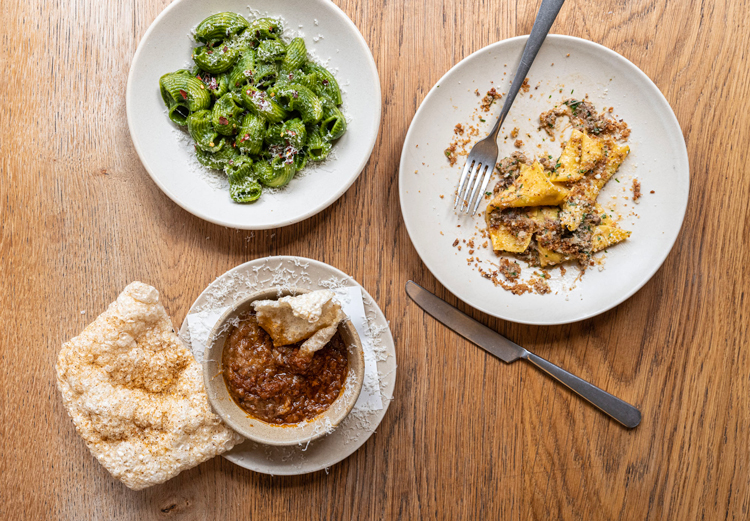

Adriana Cavita
LONDON, UK
"I need to balance traditional preparation with modern techniques. I can use traditional recipes as the basis of my creations, but I must also tap into my imagination and passion to create something new and unique."

Chetan Sharma
LONDON, UK
"For any young British Asian chef, or any chef interested in Indian cooking, I want them to be able to come into this restaurant and understand Indian food and Indian flavors, but also learn techniques and be open minded."

Rafael Cagali
LONDON / SAO PAULO
"Opening Da Terra was a reconnection to my own origins. I felt lost in a way. The name Da Terra means from the earth, the idea being not to forget what you come from. I like to think that I’m still exploring Brazilian cooking."

Andrew Clarke
LONDON, UK
"My mum didn't care I was a professional cook. She was going to cook what she wanted to cook, and love what she was doing. And there’s an honesty and beauty to that."




